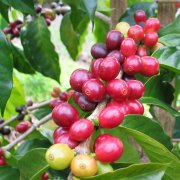The planting environment of Guatemalan coffee varieties of Guatemalan coffee
The taste of Guatemalan coffee is bitter and fragrant, and the beauty says that you will see a wonderful story in the unique smoky taste of a cup of Guatemalan Antigua coffee, which is a story about Indians.
Drinking pure Antigua coffee from Guatemala and playing a South American folk song. Our thoughts can be pulled far away, as far as we have never met before. The wise Mayans who once existed in the land of Guatemala, after a day's work under coffee trees we have never seen before, they enjoyed authentic Guatemalan coffee after dinner and watched the sunset fade away on the sea level.
Mayan culture is not only one of the most important ancient cultures in the world, but also an important classical culture in America. According to historical data, the Mayans cultivated new grain varieties that made great contributions to mankind in agricultural production, such as corn, tomatoes, pumpkins, beans, sweet potatoes, peppers, cocoa, vanilla and tobacco, among which the cultivation of corn made the greatest contribution to mankind. Although there is no record of coffee here, today, most coffee growers in Guatemala can be seen as descendants of the Mayans, and they like to be called that.
Guatemalan coffee has a strong aroma, even if you don't drink it, just smelling it is already a pleasure. Antigua coffee has a rich and velvety mellow, rich and lively aroma, and fine sour taste. When the attractive fragrance lingers on the tip of your tongue, there is an indescribable mystery. You may feel dull at the first sip, but as the coffee cools down, you will find it slightly sweet and be surprised by its depth.
Antigua coffee is popular with most coffee lovers only because of its distinctive aroma. Because it is planted in the hills of volcanoes, it can retain its own characteristics more than Costa Rica, the main reason is that it has more geographical and climatic advantages than Costa Rica. Guatemala is located in the tropics, but due to the relatively high altitude, the climate is mild, it is a subtropical climate. Under the influence of this climate, coffee trees blossom and bear fruit more slowly than coffee trees in other parts of the world. However, the mild climate and fertile soil make it an excellent environment for growing coffee

Important Notice :
前街咖啡 FrontStreet Coffee has moved to new addredd:
FrontStreet Coffee Address: 315,Donghua East Road,GuangZhou
Tel:020 38364473
- Prev

Classification of Kenyan coffee beans African boutique coffee
Usually, Kenyan coffee is classified as follows: 1) Common categories: coffee fruits picked by hand, picked by hand, picked out immature fruit (unripe), overripe fruit (overripe) and other defects, peeled, after about 36 hours of fermentation, placed on a metal grid for sun drying, in the processing plant to remove the seed shell (parchment) to become a blue-green appearance
- Next

Ole Coffee can be regarded as an European latte.
Ole coffee can be seen as an European latte, which is different from American lattes and lattes. Ole Coffee is also very simple: pour a cup of espresso and a large cup of hot milk into a large cup at the same time, and finally put two tablespoons of whipped cream on the surface of the liquid. The biggest difference between O'Lei coffee and American latte and Italian latte is that
Related
- Beginners will see the "Coffee pull flower" guide!
- What is the difference between ice blog purified milk and ordinary milk coffee?
- Why is the Philippines the largest producer of crops in Liberia?
- For coffee extraction, should the fine powder be retained?
- How does extracted espresso fill pressed powder? How much strength does it take to press the powder?
- How to make jasmine cold extract coffee? Is the jasmine + latte good?
- Will this little toy really make the coffee taste better? How does Lily Drip affect coffee extraction?
- Will the action of slapping the filter cup also affect coffee extraction?
- What's the difference between powder-to-water ratio and powder-to-liquid ratio?
- What is the Ethiopian local species? What does it have to do with Heirloom native species?

